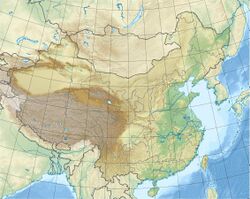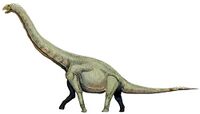Earth:Meng-Yin Formation
| Meng-Yin Formation Stratigraphic range: Berriasian-Valanginian ~145–133 Ma | |
|---|---|
| Type | Geological formation |
| Lithology | |
| Primary | Sandstone |
| Other | Siltstone |
| Location | |
| Coordinates | [ ⚑ ] : 35°54′N 118°00′E / 35.9°N 118.0°E |
| Paleocoordinates | [ ⚑ ] 36°54′N 120°12′E / 36.9°N 120.2°E |
| Region | Shandong |
| Country | |
The Meng-Yin or Mengyin Formation (simplified Chinese: 蒙阴组; traditional Chinese: 蒙陰組; pinyin: Méngyīn Zǔ) is a geological formation in Shandong, China, whose strata date back to the Berriasian and Valanginian stages of the Early Cretaceous.[1][2]
Dinosaur remains are among the fossils that have been recovered from the formation.[3] The type material for the titanosauriform dinosaur Euhelopus was excavated at this formation by Otto Zdansky in 1923, in green/yellow sandstone and green/yellow siltstone that were deposited during the Barremian or Aptian stages of the Cretaceous period, approximately 129 to 113 million years ago.[4]
Both the genus and species of Mengyinaia mengyinensis were named after the formation.
Vertebrate paleofauna
Indeterminate stegosaurid remains have been found in Shandong, China.[3]
| Vertebrates from the Meng-Yin Formation | ||||||
|---|---|---|---|---|---|---|
| Genus | Species | Location | Stratigraphic position | Material | Notes | Images |
| Euhelopus[3] | E. zdanskyi[3] | Shandong[3] | "Skull and partial postcranial skeleton, additional fragmentary skeleton."[5] | |||
| Mengshanosaurus | M. minimus | A single juvenile skull | A choristodere belonging to Neochoristodera | |||
Other fossils
- Mengyinaia mengyinensis[6]
- Fish
- Reptiles
- Ordosemys leios
- Shantungosuchus chuhsienensis[8]
- Sinemys lens
- Sinochelys applanata
- ?Dsungaripteridae indet.
- Stegosauria indet.
See also
- List of dinosaur-bearing rock formations
References
- ↑ Mengyin Formation at Fossilworks.org
- ↑ Wilson & Upchurch, 2009
- ↑ 3.0 3.1 3.2 3.3 3.4 Weishampel et al., 2004, "Dinosaur distribution (Late Jurassic, Asia).", pp.550–552
- ↑ T'an, 1923
- ↑ "Table 13.1," in Weishampel et al., 2004, p.262
- ↑ Fang et al., 2009
- ↑ XU, GUANG-HUI; CHANG, MEE-MANN (2009). "Redescription of †Paralycoptera wuiChang & Chou, 1977 (Teleostei: Osteoglossoidei) from the Early Cretaceous of eastern China". Zoological Journal of the Linnean Society 157 (1): 83–106. doi:10.1111/j.1096-3642.2009.00532.x. ISSN 0024-4082. http://dx.doi.org/10.1111/j.1096-3642.2009.00532.x.
- ↑ Young, 1961
Bibliography
- Fang, Z. J.; J. H. Chen; C. Z. Chen; J. G. Sha; X. Lan, and S. Z. Wen. 2009. Supraspecific taxa of the Bivalvia first named, described, and published in China (1927-2007). The University of Kansas Paleontological Contributions 17. 1–157.
- Wilson, Jeffrey A., and Paul Upchurch. 2009. Redescription and reassessment of the phylogenetic affinities of Euhelopus zdanskyi (Dinosauria:Sauropoda) from the Early Cretaceous of China. Journal of Systematic Palaeontology 7. 199–239. doi:10.1017/S1477201908002691
- Young, C.-C. 1961. On a new crocodile from Chuhsien, E. Shantung. Vertebrata PalAsiatica 5. 6–10.
- Wiman, C. 1929. Die Kreide-Dinosaurier aus Shantung - The Cretaceous dinosaurs of Shantung. Palaeontologia Sinica, Series C 6. 1–67.
- T'an, H. C.. 1923. New research on the Mesozoic and early Tertiary geology in Shantung. Geological Survey of China Bulletin 5. 95–135.
 |




